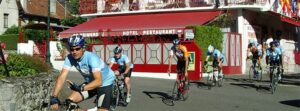Start with a neutral position ; hands in the arc of the drops (not on the flat ends) with index and middle fingers on the brake levers, and butt slightly reaward on the saddle
To go faster
Dro your head lower and farther forward, and draw your knees and elbows in.
To increase stability
Shift your weight back, raise your chest, and pedal or, if coasting, bring your tighs in against the top tube.
Tuck and coast chen pedaling no longer benefits you
According to Bicycling’s calculations, that’s about 25mph on 5 % grade, or 40mph on a 10% grade, for a 155 pound
To slow down
Shift your weight rearward as you apply noth brakes, gradually squeezing the left lever harder to engage more front brake, which supplies most of our stopping power.
It’s fine to sit while descending, but if you hit a rought strecht of pavement or a patch of gravel
Lift your butt off the saddle. « If your’re sitting, you’re reacting to what happens – you’re on defense » says 2001 world mountain bike champion Alison Dunlap. « But you want to be on offense ».
To go dangerously fast
Pros used to drop their butts so far off the back that tehir chests lay atop the saddle. Now the technique is to move so fa forward taht your chest rests atop the handlebar, and your head acts as a wedge to part the air. Keeping your hands in the drops give you a slight chance of being able to brake, but to do the full tuck, put your hands atop the flats, under your chest. This is ridiculously unstable, ill-advised – and fast.




